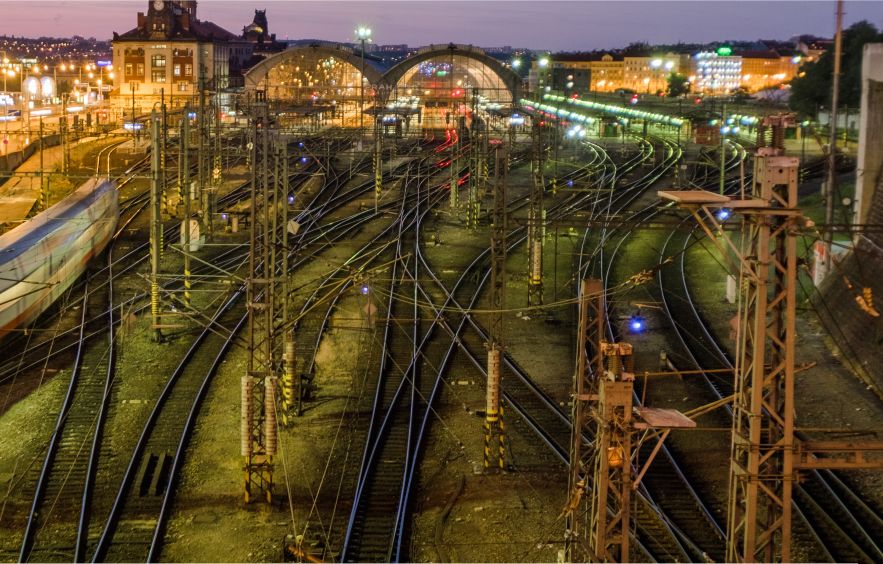
The Czech rail infrastructure manager, Správa železnic (SZ), has presented to the public the future layout of the new lines in Prague rail hub.
From the feasibility study, the Central Commission of the Ministry of Transport selected a variant with two separate lines in tunnels and a two storey station central station under the main station. In addition, it was supplemented with four more underground stops.
The Ministry of Transport has selected the option to build 10.6 km of tunnels and five new stations in the center of Prague. These tunnels are designed to intersect at two levels within the central station, beneath the central station. “One [tunnel] will lead under the existing underpasses to the platform, the other will be one level lower. Both parts of the station will be connected by a tunnel with escalators, the vestibules will be located on Winston Churchill Square and in the new departure hall of the main station,” the Minister of Transport, Martin Kupka, explained.
The capacity of each tunnel will be up to 16 trains per hour in each direction. “Underground stops will be created in Karlín, Wenceslas Square and Karlovo Square, as well as a partially buried stop in Florenc. The new routes will help separate long-distance and regional transport. This will maintain the comfort of travel, while also having a minimal impact on the environment,” the Director of the Construction Preparation Department at SZ, Pavel Paidar, said.
This selected variant is estimated at CZK 185 billion (EUR 7.3 billion).
The approved plan will now be included in strategic transport plans, and SZ will cooperate with state institutions and local governments in its preparation. The principles of territorial development and territorial plans will also be amended.
“The project brings new rail capacities right in the city centre, including several stops that will shorten the walking distance for passengers. The result will not only be a higher attractiveness of rail transport, but also the release of the busiest sections of public transport in the centre. The strengthened railway will also divert some of the traffic from the roads. Fewer cars in the city means fewer emissions, less noise and a significant improvement in the environment,” the First Deputy Mayor of the Capital City of Prague for Transport, Zdeněk Hřib, said.
More and more passengers are using suburban trains in the Prague metropolitan area which has been considered when planning other railway lines. Therefore, the Správa železnic commissioned a feasibility study several years ago to address the future form of the Prague railway hub.
“The biggest problem with transport in Prague is not transport in Prague itself, but in the metropolitan region. Prague’s modal split is highly in favor of public transport, but what is crushing Prague is precisely regional transport, where the supply and capacity are insufficient. For various historical reasons, regional and urban transport in Prague is not sufficiently interconnected, which is why the Prague railway junction project is a major breakthrough and a solution to Prague’s biggest transport problem,” Deputy Mayor of the Capital City of Prague, Petr Hlaváček, said.
The feasibility study for the Prague rail hub considered three basic designs and two additional modifications of one of them. One alternative option included two large stations under the main station and Wenceslas Square, between which trains would use a common four-track section. The second envisaged a single central station called Opera, while the original solution for the selected variant was based on faster service with fewer stops.
Passenger and freight demand in Prague rail hub has been constantly increased in the last two decades and is hitting the limits on the actual infrastructure.
Although the railway infrastructure has been modernised and the tracks have been adapted, the need for increased capacity is essential to meet the growing demand for traffic. It is necessary to increase the number of trains, both regional and suburban, as well as long-distance trains. Currently, the capacity is at a critical point, as the existing tracks and the way they are designed do not provide optimal quality for passenger traffic, while freight traffic is facing issues, with services generally being carried out in the evening.
As a result, the authorities have developed a feasibility study for the comprehensive modernisation of the existing infrastructure and its development to ensure efficient and fast transport services that can be adapted to the increasing traffic demands.
Share on:



